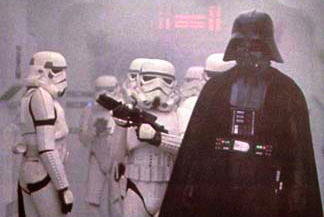
We’ve now covered all the basic elements of film—at least, the visual elements. But up to this point, we’ve been paying little attention to sound. Sound always gets short shrift in studies of film. (It shouldn’t, of course.) One reason is that it is a lot easier to comprehend the technology of sound, so it often gets glossed over. Another reason is that we simply take it for granted.
 |
||
| The soundtrack of a film is often as memorable and powerful as its image track. You can't look at a shot of Star Wars' Darth Vader without hearing John Wililams' imperial march in your head. | ||
The soundtrack glues a film together and supports it. It provides our sense of continuity in the film. And, in the typical Hollywood film, it provides a lot more information than the picture track. But it does its work unobtrusively, so it’s usually the picture track that gets all the attention.
Movies Without Pictures?
As we’ve noted earlier, cinema without pictures makes more sense than cinema without sound. In fact, even the term "silent picture" is a misnomer. All "silents" were accompanied by a music track—it just wasn’t recorded on the film until the late 1920s.
So why is sound so important? Is it really possible that a film without any moving pictures would work better than the alternative―a film without any sound?
Envision an alternate universe in which the sentient beings have perfect vision: they can perceive the change in an image in, say, a millionth of a second. In other words, unlike us they have no measurable persistence of vision. The result? Motion pictures simply aren’t possible. At least, not yet at our (and their) current level of technology.
Yet they still have a vibrant culture of cinema. They go out to the talkies and sit in theaters and listen. Nearly all the theaters project still images on the wall at the front to accompany the talkies. It’s sort of like a light show. It’s nice, but not necessary.
These talkies are very much like our own movies. They have dramas and comedies. There is lots of music. They have fewer westerns and hardly any disaster movies. There are no crash-and-burn epics and fewer action-adventure shows. They even have poetry talkies (we have hardly anything to compare to this). And musicals are a lot more prevalent than they are here.
On the home front, they have no television, but they do have “telaudition”―a form of entertainment sort of like our radio. And one more thing: like we did a hundred years ago, they had a vibrant popular theatrical culture. Unlike us, they had no talking pictures to replace it, so it still exists and, in fact, has grown and matured. Their theatre culture is tightly intertwined with the talkie industry―each informs and inspires the other. They also have a much more vibrant culture of painting and sculpture. Indeed, everyone draws and paints. They like the visual as much as we do.
They just can’t see movies as we do.
Could you imagine it? Were you able to picture an audio-based movie? The truth is, visuals and sound go hand-in-hand. We’ve grown so used to it being that way that a film without either pictures or sound probably wouldn’t be very well-received. But it’s interesting to hypothesize about it because it helps to draw attention to an undeniable fact that is sadly overlooked by most moviegoers: sound is important.
The first step in learning about sound in film is really just acknowledging its importance. The next step is understanding the components of a soundtrack, learning about the people responsible for creating those pieces, and taking a glimpse at how it all comes together to become a unified driving force behind a movie.